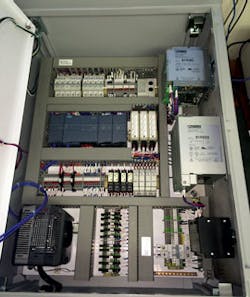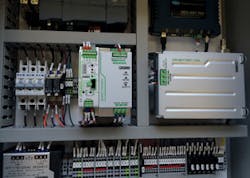Moving Beyond Mechanical: Streamlining Water Management Systems with Automated Electronic Control
By Ryan Spooner
For many years, water management systems have exclusively used mechanical components. There is no doubt that these tried-and-true systems have provided useable results, but in recent years, there has been a large push to develop better methods for controlling water. The primary focus for solutions has been in the areas of reducing maintenance, saving water and reducing pipe breakage. With our ever-growing population, it has become a necessity to be able to control a large municipal water supply from one central location.
Designing such large, complex systems is no easy task. The design starts at each individual chamber by choosing the correct control valve. Even when a valve is deemed right for the application, it is usually used for specific situations. For example, a pressure-reducing chamber may be set based on high capacity flows and pressures of the system. However, a large system that reduces pressure to the same point at all times of the day can inflict excess stress. Being able to fluctuate the pressure set-points as the system demands, such as for nighttime and daytime flow, can prevent pipe breakages, reduce water loss and improve overall efficiency of the system.
A control panel will provide the capabilities to have a live system and gain access to the chamber at any time of the day with the ability to change the pressure set-point based on the feedback. All this can be achieved from a local control room rather than traveling throughout the city from chamber to chamber to change mechanical set-points. Depending on the size of the distribution system and the variable demands, the design can become very complex.
Choosing what to Control
The first question to ask is, "What am I trying to control?" A few of the most common options are:
- Flow control
- Pressure reducing control
- Pressure sustaining control
- Valve position control
- Tank level control
- Booster pump control
- Surge anticipation control
Choosing one option or three, a panel can be designed and programed with the most efficient algorithm based on your application's priority sequence, ensuring the system works exactly as you expect it to. The type of control or the way you would prefer to control a system is often based on what types of feedback elements you plan to use -- these may be sensors or switches purchased with your valve or existing components already connected to your system.
A good control panel can integrate with one or many of these feedback modules and control the system to user set-points. One implementation could be as basic as using a control panel to control a single valve for position or pressure management or possibly using that same panel to control two valves in one station for position or pressure management.
A more complex design can use flow rate as a primary feedback element for filling a tank while simultaneously monitoring pressure as a sustaining feature and tank level control for system alarms. This type of configuration would ensure that the system does not overdraw water upstream of the valve -- all while filling and monitoring the level of the tank.
Maintenance and Control
The second question to ask is, "How will the system be maintained and controlled?" Some control panels have the option to be controlled locally on site or remotely off site. Depending on the size of the system or site, this becomes a key feature to consider in controls. It may be beneficial for on-site staff to adjust a valve parameter based on the changes in site parameters, or it may be beneficial for site parameters to change and automatically adjust valve parameters remotely. Using the local control mode, the control panel has the capability to open and close the valve manually or switch to the aforementioned autonomous control algorithms.
A control panel can also be integrated with a SCADA system via 4-20 mA signals and dry contacts or via industrial communication protocols such as Modbus. The panel can receive all necessary set-points and I/O controls and retransmit any necessary data needed. Once the communication protocols are set and the control algorithm of the system is decided, the final features to consider are the desired inputs and outputs.
A digital input is usually used to remotely control an option on the panel. For example, a remote input can be used to open and close the valve or to turn on and off a specific control sequence. A digital output of the system is usually configured as an alarm or status indicator. The most common uses of this feature are to indicate signal loss from a feedback device or to indicate whether the system is currently idle or running a control sequence.
Installation and Power Source
The last questions to ask are, "Where is the best installation location?" and "Where is a power source?" A control panel can be designed for either AC or DC input supply voltages. The environment in which the panel will be installed will also need to be considered. Installation locations can vary, from mounting a panel next to the valve in a chamber where moisture may be a concern to mounting a panel aboveground out of a chamber where sun may be a concern. A control panel can accommodate both indoor and outdoor installations.
In some applications, an internal door, which holds the touchscreen display and any other buttons or indicators, is installed to minimize exposure to the elements and prevent damage to sensitive components.
When choosing your panel, consider the following checklist:
- Type of control
- Sensor inputs
- SCADA/remote inputs
- SCADA/retransmission outputs
- Alarm outputs
- Supply voltage
- Indoor/outdoor use
When all parts of the checklist are answered, the work on the control panel can begin. A valve manufacturer can supply both the control panel and the control valve it integrates with. The best way to think of a control valve and its panel is as a control package. With the checklist complete, the manufacturer can turn the control sequence into PLC logic to program the panel to your specifications. Depending on the application, the turnaround time on a small panel can be as quick as four weeks.
If you are a novice with electronics, your best option is to have a valve manufacturer come to the site and start up and commission the control panel. Start-up of the control panel includes commissioning of the valves, sensor setup, system input checks, and a full magnitude of testing, as well as complete training on the system. A good control panel is designed to be as user-friendly as possible. Once it's set up and training has been provided, you will be fully capable of taking over control of your panel. However, over time, if you feel the need for more training or want to make changes to the panel, your valve manufacturer will have records of your panel and code (usually based on a serial number tagged on your control panel).
A good, customized control panel can save a municipality many man hours, prevent loss of water, avoid potential disaster from an unknown situation, and offer peace of mind that the system is operating as it should 24 hours per day -- all with live feedback and the ability to make system parameter changes instantly at your fingertips. As the world around us becomes increasingly electronic in nature, so too can valve systems enjoy the freedom and security of electronic automation.
About the Author: Ryan Spooner is the automation and instrumentation engineer for Singer Valve. He has a degree in Mechatronics Engineering and has a deep understanding of electronics and a solid background in valve mechanics. Spooner designs and builds customized control panels, commissions and integrates systems with Singer valves and runs operator training sessions onsite.
More WaterWorld Current Issue Articles
More WaterWorld Archives Issue Articles




